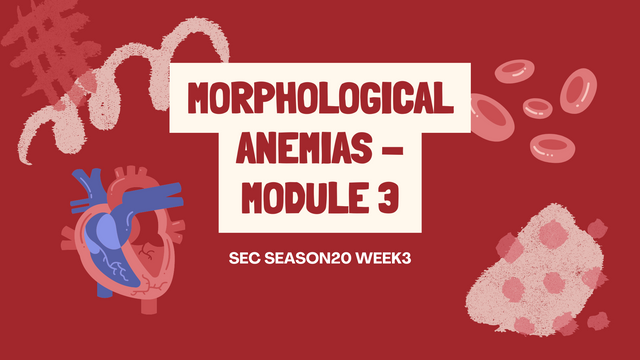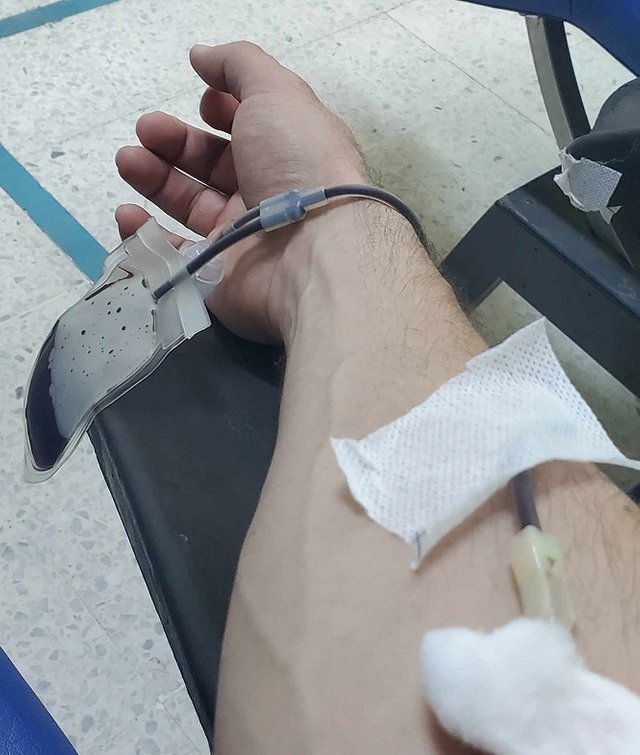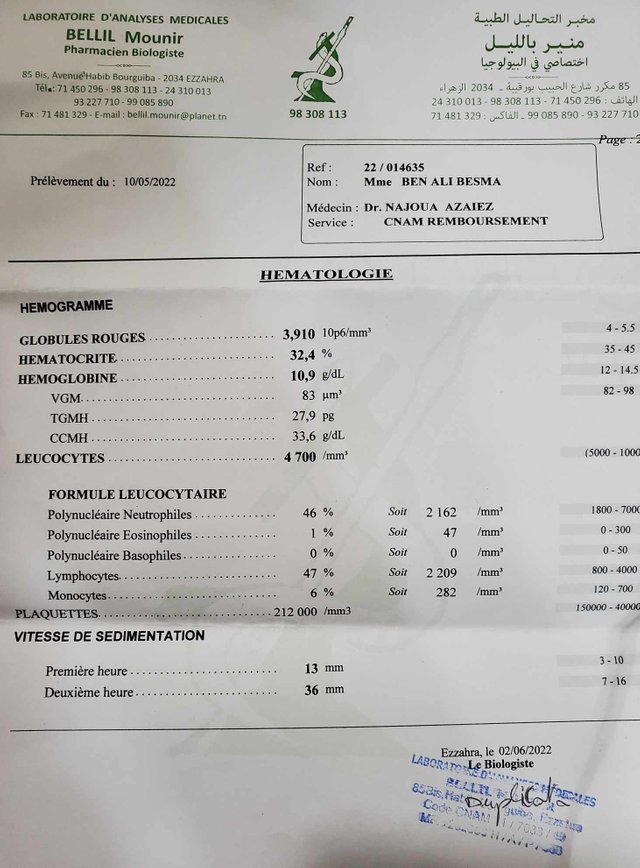
Hello steemians,
I am participating in this competition to enrich my understanding of morphological anemias, a key topic in hematology. Through my analysis, I will examine in depth the different classifications of anemia, discuss their pathophysiology, and apply this knowledge to a specific clinical case. As someone who has never suffered from anemia, I will also share my perspective and the results of my wife's healthy blood tests, while exploring the implications and possible treatments for this complex pathology.
Define Morphological Anemia
Morphological anemia, we define it by examining the red blood cells under a microscope. According to their size, shape and color, I can classify the anemia to better understand its origin and guide the treatment. Through this classification, three main types of anemia are distinguished.
Microcytic: When I observe red blood cells that are smaller than normal and often paler, I speak of microcytic anemia. This type of anemia is often caused by an iron deficiency or thalassemia. The small size of the red blood cells reflects a lack of production of hemoglobin, the element that carries oxygen in the blood.
Normocytic: If the red blood cells are of normal size but their number is insufficient, I speak of normocytic anemia. This can be due to acute blood loss, chronic diseases or bone marrow disorders. In this case, the red blood cells are produced normally, but their quantity is reduced due to various underlying pathologies.
Macrocytic: When I notice that the red blood cells are larger than normal, I call it macrocytic anemia. This type of anemia is often caused by a deficiency of vitamin B12 or folic acid, or by diseases such as liver disease or hypothyroidism. The large size of the red blood cells usually indicates inadequate maturation of the cells in the bone marrow.
By classifying anemia in this way, I can better target the underlying cause and choose the most appropriate treatment.
Have you ever had anemia?
I have never suffered from anemia, and I thank God for that. All my regular blood tests have always shown normal results, which reflects good overall health. For example, in my last tests, my hemoglobin level was 14.5 g/dL, which is well within the normal range for an adult male, which is usually between 13.8 and 17.2 g/dL. In addition, my serum iron levels were 100 µg/dL, corresponding to a normal value that is between 65 and 175 µg/dL.


I take care to maintain a balanced diet, rich in iron and essential vitamins, in order to prevent any deficiency. The hematocrit measurements, which reflect the proportion of red blood cells in the blood, were also normal, at 45%, while the norm is between 40 and 54% for a man. These results show that thanks to good eating habits and regular medical monitoring, I have never shown signs of anemia.
On the other hand, my wife suffered from a form of hypochromic microcytic anemia, probably due to iron deficiency, as her test results in the French language show.

- Hemoglobin: 10.9 g/dL (lower than normal for an adult woman, usually between 12 and 16 g/dL)
- Hematocrit: 32.4% (lower than normal for a woman, usually between 35 and 45%)
- MCV (Mean corpuscular volume): 83 µm³ (slightly lower than normal, the norm being between 82 and 98 µm³)
- TGMH (Mean corpuscular hemoglobin content): 27.9 pg (lower than the norm, which is between 27 and 32 pg)
- MCHC (Mean corpuscular hemoglobin concentration): 33.6 g/dL (normal, the norm being between 32 and 36 g/dL)
- Red blood cells: 3,910 x 10⁶/mm³ (below the norm for an adult woman, which is between 4.5 and 5.5 x 10⁶/mm³)
- Leukocytes: 4,700/mm³ (normal, the norm being between 5,000 and 10,000/mm³)
- Platelets: 212,000/mm³ (within the norm, which is between 150,000 and 400,000/mm³)
Analysis:
These results show that my wife has hypochromic microcytic anemia, probably related to iron deficiency. This is supported by a low hemoglobin level (10.9 g/dL), a low hematocrit (32.4%), a mean corpuscular volume (MCV) slightly below normal, and a mean hemoglobin content in red blood cells also below normal values.
These findings suggest that the anemia is mild to moderate, and it may require iron supplementation and a diet rich in essential nutrients such as iron and B vitamins to help improve blood health status.
Pathophysiologically, what happens with anemia?
Anemia occurs when the body does not have enough healthy red blood cells to transport oxygen to the tissues efficiently. From a pathophysiological point of view, several mechanisms can explain this insufficiency.
First of all, it may be a reduced production of red blood cells. This can be due to a deficiency of essential nutrients like iron, vitamin B12, or folic acid, which are needed to make red blood cells in the bone marrow. For example, in the case of iron deficiency, the body cannot produce enough hemoglobin, the protein that allows red blood cells to carry oxygen.
Then there can be an increased destruction of red blood cells, a phenomenon called hemolysis. This mechanism is present in some autoimmune or hemolytic diseases where red blood cells are destroyed faster than the bone marrow can replace them.
Another factor is excessive blood loss, such as during acute or chronic bleeding. This can cause a rapid decrease in the number of red blood cells, leading to severe anemia. When there is significant blood loss, the body tries to compensate by increasing the production of red blood cells but it may not be able to keep up, resulting in anemia.
In all of these cases, the result is the same, there are fewer red blood cells available to carry oxygen to the tissues. This leads to symptoms such as fatigue, weakness, shortness of breath and sometimes heart palpitations because the organs and muscles are receiving less oxygen than they need to function properly.
Case Study: A woman arrives at the emergency room of the Ruiz y Páez Hospital Complex, unconscious and with signs of paleness. The doctor tells her to perform a complete hematology and an HCG. The results of the homology indicate hemoglobin 9 g/dl, MCV 71 fL, HCM 24 pg, CHCM 27 g/L and positive HCG. Classify the anemia morphologically and explain what you understood about the clinical case.
In this clinical case, a woman arrived unconscious at the emergency room with signs of pallor. The results of her hematology analysis reveal the following:
- Hemoglobin: 9 g/dL (below normal, which is usually 12 to 16 g/dL for women)
- Mean corpuscular volume (MCV): 71 fL (indicating smaller than normal red blood cells, as the norm is usually 80 to 100 fL)
- Mean corpuscular hemoglobin (MCH): 24 pg (reduced, the norm is usually 27 to 32 pg)
- Mean corpuscular hemoglobin concentration (MCHC): 27 g/dL (low, the norm is usually 32 to 36 g/dL)
- Positive HCG (human chorionic gonadotropin, indicating pregnancy)
Classification of anemia
Based on these results, anemia can be morphologically classified as anemia hypochromic microcytic. This means that the red blood cells are smaller than normal (microcytic) and have a lower concentration of hemoglobin, making them appear paler (hypochromic). The reduced hemoglobin levels (9 g/dL) confirm the presence of anemia, while the low MCV (71 fL) and low CHCM (27 g/dL) indicate hypochromic microcytic anemia.
Interpretation of the clinical case
This case suggests that the patient has hypochromic microcytic anemia, potentially due to iron deficiency, which is one of the most common causes of this type of anemia, especially in pregnant women.
Pregnancy, confirmed by positive HCG, can worsen the situation, as iron requirements increase significantly during gestation to support both the mother and the fetus. The combination of anemia and pregnancy may explain the severe symptoms, such as paleness and unconsciousness, because the body is unable to transport enough oxygen to vital organs.
This woman may have pregnancy-related iron deficiency anemia, which could explain her blood test results. Prompt treatment of this anemia with iron supplements, an iron-fortified diet, and regular monitoring is crucial to protect the health of the mother and unborn child.
References:
- Anemia Classification - National Heart, Lung, and Blood Institute. Available at: https://www.nhlbi.nih.gov/health-topics/anemia
- Reference Ranges for Blood Tests-Mayo Clinic. Available at: [https://www.mayoclinic.org/tests-procedures/complete-blood-count/about/pac-20384919](https://www.mayoclinic.org/tests-procedures/complete-blood-count /about/pac-20384919)
- Hemolytic Anemia Overview - American Society of Hematology. Available at: https://www.hematology.org/education/patients/anemia/hemolytic-anemia
- Iron Deficiency Anemia in Pregnancy - National Health Service (NHS). Available at: https://www.nhs.uk/pregnancy/keeping-well/anemia-iron-deficiency/
Thank you very much for reading, it's time to invite my friends @lil.albab, @miftahulrizky, @heriadi to participate in this contest.
Best Regards,
@kouba01

I took a blood test and was surprised to find out that my cholesterol was high. Since then I have been exercising regularly and avoiding greasy food. Preventing illness is more important than treating it.
Downvoting a post can decrease pending rewards and make it less visible. Common reasons:
Submit
I agree completely with you. Prevention is essential to maintaining good health. By exercising regularly and watching your diet, you are taking important steps toward preventing disease in the long term. It’s a proactive approach that’s beneficial to your well-being.
Downvoting a post can decrease pending rewards and make it less visible. Common reasons:
Submit
Downvoting a post can decrease pending rewards and make it less visible. Common reasons:
Submit
It is important to shed light on a serious issue like anemia, many will benefit from your post. Thank you. Best wishes to you.
Downvoting a post can decrease pending rewards and make it less visible. Common reasons:
Submit
Thank you !
Downvoting a post can decrease pending rewards and make it less visible. Common reasons:
Submit
This is an awesome post! I love how you broke down the different types of morphological anemia—it really helps in understanding the complexities of hematology. Your personal touch with your wife's experience adds depth to your analysis, making it relatable. I’m amazed at how easily and perfectly you explained this topic; even some medical students find organizing all this information quite challenging! By the way, I’m curious to know what your profession is? You seem like an amazing all-rounder! Haha. Great post, my friend
Downvoting a post can decrease pending rewards and make it less visible. Common reasons:
Submit
Thank you so much my friend. My wife's experience definitely added a personal perspective that I hoped would make the information more relatable. To answer your question, I’m actually a computer science teacher, but I enjoy exploring and learning about a variety of subjects, including medical topics. I appreciate your support, my friend!
Downvoting a post can decrease pending rewards and make it less visible. Common reasons:
Submit